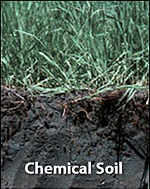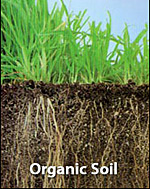

 Call
and ask about our Early Bird Discounts on Lawn Care Programs 860-859-3100
Call
and ask about our Early Bird Discounts on Lawn Care Programs 860-859-3100
| Soil
Analysis & The Soil FoodWeb |
||||
| Organic
Fertilizer is only a part of the equation. Why do we Analyze your Soil? The purpose of the soil tests we take is to determine which nutrients are present in your soil and are either deficient or in excess. We also gather information that tells us about the structure and composition of your soil, and the relative health of the soil biology. This information allows us to customize a program to restore health to your soil and proper nutrient balance for your plants. Our standard Soil Analysis includes two types of results. One type (CEC) tells us which nutrients are present in your soil. The other (REAMS) tells us which are "plant available" and in what amounts. Your lawn is a cover crop; it must grow in the same soil year after year. Nutrients are constantly being extracted and used, creating imbalances. It is crucial that they be replaced or unlocked for the grass to be healthy. Health means more than just adding NPK; it is more than just creating appropriate soil chemistry. Every plant must be supported by the right biology: a healthy infrastructure of microorganisms called a soil foodweb. If soil contains the correct organisms in the right amount, nutrients will become available, plant growth can be enhanced, and disease and pest issues can be greatly reduced. The Soil Foodweb: The foodweb contains a combination of beneficial and pathogenic organisms, including bacteria, fungi and other microbes. Balance is critical. Most lawn grasses perform best in soil that has slightly more beneficial bacteria than fungi, while trees and shrubs do better with a greater amount of fungi than bacteria. If the balance of organisms is wrong, fertilizers and pesticides can create the illusion of a healthy plant above the soil, while below the soil, weed growth and disease are actively being promoted. For example, soil with very high amounts of bacteria, but few fungi, contains nitrogen in a form which weeds can use but grass plants can’t. Consequently, weeds grow well in the compromised soil, requiring the use of herbicides, which often destroy the few remaining good bacteria. The pathogenic bacteria often survive pesticide applications better and by remaining in the soil, make conditions favorable for weed growth. The impact of In-organic Fertilizers and Pesticides This pattern creates a downward spiral of continuously larger and stronger pesticide applications treating symptoms, but never addresses the root cause. These fertilizers also tend to overstimulate growth requiring irrigation and mowing more often. All beneficial microbes are very sensitive to the high salt content in inorganic fertilizers as well as the salt and chlorine in pesticides. In nature, plants depend on these beneficial microorganisms around their roots for survival. Organic applications will not only help prevent this negative downward spiral effect, but also facilitate plant health in a dramatically more efficient manner. Over time this helps your lawn and landscape thrive with a fraction of the effort required in traditional programs. Plants need N, P, K, calcium, magnesium and trace minerals applied at the right levels and the right times in order to flourish. Most fertilizer applications try to feed the plant directly by adding large amounts of NPK at one time, which often does not correspond to the rates, forms and places that plants need. Organic applications feed the beneficial soil organisms, which convert nutrients and make them available to the plant in the right form. These beneficial microorganisms also help retain unused nutrients, preventing them from leaching out of the soil until the plant needs them. Plants don’t have the enzymes to break down organic matter, so they rely on the soil organisms to convert it into usable forms. In turn, the plant feeds the organisms by the secretion of sugars, proteins, and carbohydrates from its roots. A healthy soil foodweb also protects plants from diseases and pests, and even remediate some toxic compounds. While soil biology and chemistry are interdependent, the biology takes precedence because it is alive and can grow. The biology of the soil profoundly influences the chemistry. For example, adding lime to soil increases its alkalinity (pH) because the lime feeds bacteria which are highly alkaline. The soil test benefits our organic program by providing a clear picture of your soil ecosystem. Only deficient nutrients are applied. The correct microbes and food sources can be added to release what is already present. Actively promoting the health of the soil foodweb, along with conditioning your soil to achieve balanced chemistry, will enable your landscape to become a healthy ecosystem in the most efficient manner. |
Healthy
soil is a critical component of a healthy |
|||



